 |
50 (1) (1998), pp. 12-18. |
|---|
 |
50 (1) (1998), pp. 12-18. |
|---|
The Titanic began its maiden voyage to New York just before noon on April 10, 1912, from Southampton, England. Two days later at 11:40 p.m., Greenland time, it struck an iceberg that was three to six times larger than its own mass, damaging the hull so that the six forward compartments were ruptured. The flooding of these compartments was sufficient to cause the ship to sink within two hours and 40 minutes, with a loss of more than 1,500 lives. The scope of the tragedy, coupled with a detailed historical record, have fueled endless fascination with the ship and debate over the reasons as to why it did in fact sink. A frequently cited culprit is the quality of the steel used in the ship's construction. A metallurgical analysis of hull steel recovered from the ship's wreckage provides a clearer view of the issue.
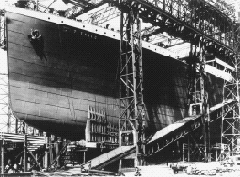 |
| Figure 1. The Titanic under construction at the Harland and Wolff shipyard in Ireland. (Photo courtesy of the Titanic Historical Society.) |
The designed speed for these ships was 21-22 knots, in contrast to the faster Cunard ships. To achieve this speed, each ship had three propellers; each outboard propeller was driven by a separate four-cylinder, triple expansion, reciprocating steam engine.2 The center propeller was driven by a low-pressure steam turbine using the exhaust steam from the two reciprocating engines. The power plant was rated at 51,000 I.H.P. To provide the necessary steam for the power plant, 29 boilers were available, fired by 159 furnaces. In addition to propelling the ship, steam was used to generate electricity for various purposes, distill fresh water, refrigerate the perishable food, cook, and heat the living space. Coal was burned as fuel at a rate of 650 tons per day when the ship was underway. Stokers moved the coal from the bunkers into the furnaces by hand. The bunkers held enough coal for a ten-day voyage.
| THE LIVES OF THE SISTER SHIPS |
|---|
| The RMS Olympic made more than 500 round trips between Southampton and New York before it was retired in 1935 and was finally broken up in 1937. In 1919, it became the first large ship to be converted from coal to oil. On May 15, 1934, as the Olympic approached New York, it struck the Nantucket light ship during a heavy fog, cutting it in half. Of the crew, four were drowned, three were fatally injured, and three were rescued.1
The third ship of the series, the Britannic, had a short life. While it was being constructed, the Titanic was sunk. Immediately, the design was changed to provide a double hull and the bulkheads were extended to the upper deck. Before the Britannic was completed, World War I broke out, and the vessel was converted into a hospital ship. On November 21, 1916, it was proceeding north through the Aegean Sea east of Greece when it struck a mine. Because the weather had been warm, many of the portholes had been opened, hence rapid flooding of the ship occurred. The ship sank in 50 minutes with a small loss of life; one of the loaded life boats was drawn into a rotating propeller. |
The construction of the Titanic was delayed due to an accident involving the Olympic. During its fifth voyage,3 the Olympic collided with the British cruiser, HMS Hawke, damaging its hull near the bow on the port (left) side. This occurred in the Solent off Southampton on September 20, 1911. The Olympic was forced to return to Belfast for repairs. To accomplish the repairs in record time and to return the ship to service promptly, workmen were diverted from the Titanic to repair the Olympic.
On April 2, 1912, the Titanic left Belfast for Southampton and its sea trials in the Irish Sea. After two days at sea, the Titanic, with its crew and officers, arrived at Southampton and tied up to Ocean Dock on April 4. During the next several days, the ship was provisioned and prepared for its maiden voyage.
| Table I. A Summary of Damaged Areas in Hull by Compartment*6 | |
|---|---|
| Compartment | Computer Calculations (m2) |
| Fore Peak Cargo Hold 1 Cargo Hold 2 Cargo Hold 3 Boiler Room 6 Boiler Room 5 Total Area |
0.056 0.139 0.288 0.307 0.260 0.121 1.171 |
| *The compartments are listed in order from the bow toward the stern. | |
On the moonless night of April 14, the ocean was very calm and still. At 11:40 p.m., Greenland time, the lookouts in the crow's nest sighted an iceberg immediately ahead of the ship; the bridge was alerted. The duty officer ordered the ship hard to port and the engines reversed. In about 40 seconds, as the Titanic was beginning to respond to the change in course, it collided with an iceberg estimated to have a gross weight of 150,000-300,000 tons. The iceberg struck the Titanic near the bow on the starboard (right) side about 4 m above the keel. During the next 10 seconds, the iceberg raked the starboard side of the ship's hull for about 100 m, damaging the hull plates and popping rivets, thus opening the first six of the 16 watertight compartments formed by the transverse bulkheads. Inspection shortly after the collision by Captain Edward Smith and Thomas Andrews, a managing director and chief designer for Harland and Wolff and chief designer of the Titanic, revealed that the ship had been fatally damaged and could not survive long. At 2:20 a.m., April 15, 1912, the Titanic sank with the loss of more than 1,500 lives.
At the time of the accident, there was disagreement among the survivors as to whether the Titanic broke into two parts as it sank or whether it sank intact. On September 1, 1985, Robert Ballard5 found the Titanic in 3,700 m of water on the ocean floor. The ship had broken into two major sections, which are about 600 m apart. Between these two sections is a debris field containing broken pieces of steel hull and bulkhead plates, rivets that had been pulled out, dining room cutlery and chinaware, cabin and deck furniture, and other debris.
The only items to survive at the site are those made of metals or ceramics. All items made from organic materials have long since been consumed by scavengers, except for items made from leather such as shoes, suitcases, and mail sacks; tanning made leather unpalatable for the scavengers. The contents of the leather suitcases and mail sacks, having been protected, have been retrieved and restored. Ethical and legal issues associated with the recovery of such items are described in the sidebar authored by C.R. McGill.
| Table II. The Composition of Steels from the Titanic, a Lock Gate, and ASTM A36 Steel | |||||||||
|---|---|---|---|---|---|---|---|---|---|
| C | Mn | P | S | Si | Cu | O | N | MnS: Ratio | |
| Titanic Hull Plate | 0.21 | 0.47 | 0.045 | 0.069 | 0.017 | 0.024 | 0.013 | 0.0035 | 6.8:1 |
| Lock Gate* | 0.25 | 0.52 | 0.01 | 0.03 | 0.02 | — | 0.018 | 0.0035 | 17.3:1 |
| ASTM A36 | 0.20 | 0.55 | 0.012 | 0.037 | 0.007 | 0.01 | 0.079 | 0.0032 | 14.9:1 |
| *Steel from a lock gate at the Chittenden ship lock between Lake Washington and Puget Sound, Seattle, Washington. | |||||||||
 |
 |
| Figure 2. An optical micrograph of steel for the hull of the Titanic in (a—top) longitudinal and (b—bottom) transverse directions, showing banding that resulted in elongated pearlite colonies and MnS particles. Etchant is 2% Nital. |
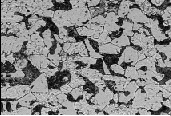 |
| Figure 3. The microstructure of ASTM A36 steel showing ferrite and pearlite. The mean grain diameter is 26.173 µm. Etchant is 2% Nital. |
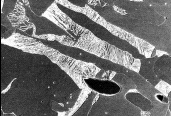 |
| Figure 4. A scanning electron micrograph of the etched surface of the Titanic hull steel showing pearlite colonies, ferrite grains, an elongated MnS particle, and nonmetallic inclusions. Etchant is 2% Nital. |
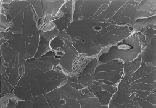 |
| Figure 5. A scanning electron micrograph of a Charpy impact fracture surface newly created at 0°C, showing cleavage planes containing ledges and protruding MnS particles. |
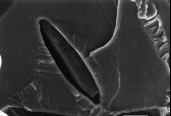 |
| Figure 6. A scanning electron micrograph showing a fractured MnS particle protruding edge-on from the fracture surface.13 |
Davies7 has shown that at the time the Titanic was constructed about two-thirds of the open-hearth steel produced in the United Kingdom was done in furnaces having acid linings. There is a high probability that the steel used in the Titanic was made in an acid-lined open-hearth furnace, which accounts for the fairly high phosphorus and high sulfur content. The lining of the basic open-hearth furnace will react with phosphorus and sulfur to help remove these two impurities from the steel. It is likely that all or most of the steel came from Glasgow, Scotland.
Included in Table II are the compositions of two other steels: steel used to construct lock gates at the Chittenden Ship Lock between Lake Washington and Puget Sound at Seattle, Washington,8 and the composition of a modern steel, ASTM A36. The ship lock was built around 1912, making the steel about the same age as the steel from the Titanic.
Figure 4 is a scanning electron microscopy (SEM) micrograph of the polished and etched surface of steel from the Titanic. The pearlite can be resolved in this micrograph. The dark gray areas are ferrite. The very dark elliptically shaped structure is a particle of MnS identified by energy-dispersive x-ray analysis (EDAX). It is elongated in the direction of the banding, suggesting that banding is the result of the hot rolling of the steel. There is some evidence of small nonmetallic inclusions and some of the ferrite grain boundaries are visible.
The tensile-test results are given in Table III. These data are compared with tensile-test data for an SAE 1020 steel, which is similar in composition. The steel from the Titanic has the lower yield strength, probably due to a larger grain size. The elongation increases as well, again due to a larger grain size.
Figure 5 is an SEM micrograph of a freshly fractured surface of a longitudinal Charpy specimen tested at 0°C. The cleavage planes, (100) in ferrite, are quite apparent. There are cleavage plane surfaces at different levels that are defined by straight lines. These straight lines are steps connecting parallel cleavage planes; the edges are parallel to the [010] direction. The crystallographic surfaces of the risers are the (001) plane. In addition, there are curved slip lines on the cleavage planes.
Particles of MnS identified by EDAX can be observed. Some of the MnS particles exist as protrusions from the surface. These protrusions were pulled out of the complimentary fracture surface. In addition, there are the intrusions remaining after the MnS particles have been pulled out of this fracture surface. One of the pearlite colonies lying in the fracture surface is oriented so that the ferrite and cementite plates have been resolved. Figure 6 shows a fractured lenticular MnS particle that protrudes edge-on from the fractured surface.13 There are slip lines radiating away from the MnS particle.
| Table III. A Comparison of Tensile Testing of TitanicSteel and SAE 1020 | ||
|---|---|---|
| Titanic | SAE 102011 | |
| Yield Strength | 193.1 MPa | 206.9 MPa |
| Tensile Strength | 417.1 MPa | 379.2 MPa |
| Elongation | 29% | 26% |
| Reduction in Area | 57.1% | 50% |
Comparing the composition of the Titanic steel and ASTM A36 steel shows that the modern steel has a higher manganese content and lower sulfur content, yielding a higher Mn:S ratio that reduced the ductile-brittle transition temperature substantially. In addition, ASTM A36 steel has a substantially lower phosphorus content, which will also lower the ductile-brittle transition temperature. Jankovic8 found that the ductile-brittle transition temperature for the Chittenden lock gate steel was 33°C. The longitudinal specimens of the Titanic hull steel made in the United Kingdom and those specimens from the Chittenden lock steel made in the United States have nearly the same ductile-brittle transition temperature.
 |
 |
| Figure 7. Charpy impact energy versus temperature for longitudinal and transverse Titanic specimens and ASTM A36 steel. | Figure 8. Shear fracture percent from Charpy impact tests versus temperature for longitudinal and transverse Titanic specimens and ASTM A36 steel. |
ACKNOWLEDGEMENTSThe authors thank G. Tullock of RMS Titanic, Inc., for supplying the steel from the Titanic and W. Garzke, Jr., of Gibbs and Cox, for his assistance in securing the steel. Thanks to D. Brown and M.K. Johnson and their associates of Laclede Steel Company for the chemical analysis of the steel. S. Miller of the Electron Microscope Laboratory and associate professor C. Ramsay are thanked for their assistance. Thanks to T. Foecke of the Metallurgy Division, National Institute of Science and Technology, for providing Figure 6. Last, but certainly not least, the authors acknowledge the assistance of M. Roberson, J. Jones, G. Papen, and D. Murphy of the School of Mines and Metallurgy shop at the University of Missouri-Rolla for their valuable assistance in preparing specimens and providing technical support.
Supplemental Reading
References1. New York Times, 83 (May 16, 1934), p. 1:4, 3:1, 3:5.2. Ocean Liners of the Past: The White Star Triple Screw Atlantic Liners (New York: Ameron House, 1995). 3. T.E. Bonsall, Titanic (Baltimore, MD: Bookman Publishing Co., 1987), p. 32. 4. C. Pellogrino, Her Name, Titanic (New York: Avon Books, 1988), p. 124. 5. R.B. Ballard with Rick Archbold, The Discovery of the Titanic (New York: Warner Books, 1987). 6. C. Hackett and J.G. Bedford, The Sinking of the Titanic: Investigated by Modern Techniques (The Northern Ireland Branch of the Institute of Marine Engineers and the Royal Institution of Naval Architects, March 26, 1996). 7. R. Davies, Historical Metallurgy, 29 (1995), p. 34. 8. A. Jankovic, Did Metallurgy Sink the Titanic (Senior Project Report, Department of Metallurgical Engineering, University of Washington, Seattle, November 1991). 9. R.J. Brigham and Y.A. Lafrenière, Titanic Specimens, 92-32(TR) (Ottawa, Canada: Metals Technology Laboratories, CANMET, 1992). 10. Standard Test Methods and Definitions for Mechanical Testing of Steel Products (Philadelphia, PA: ASTM A370-95a, 1995), p. 2. 11. Metals Handbook, 1 (8) (Metals Park, Ohio: ASM, 1961), p. 188. 12. Standard Test Methods and Definitions for Mechanical Testing of Steel Products (Philadelphia, PA: ASTM A370-95a, 1995), p. 7. 13. Figure 6 provided by T. Foecke (Gaithersburg, MD: Metallurgy Division, NIST).
Katherine Felkins is a student at the University of Missouri-Rolla. H.P. Leighly, Jr., is a professor of metallurgical engineering at the University of Missouri-Rolla. A. Jankovic is a materials test engineer. For more information, contact H.P. Leighly, Jr., Department of Metallurgical Engineering, University of Missouri-Rolla, Rolla, Missouri 65409-0340; (573) 341-4735; fax (573) 341-6934; e-mail hpl@umr.edu.
|
|
Direct questions about this or any other JOM page to jom@tms.org.
| Search | TMS Document Center | Subscriptions | Other Hypertext Articles | JOM | TMS OnLine |
|---|